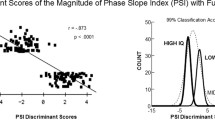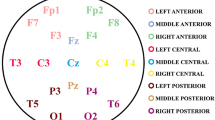Abstract
Relationships between individual θ and α EEG amplitudes and intelligence were studied in five- to six-year-old children. EEG was recorded in 83 children in three functional states: eyes closed, sustained visual attention, and attention to adult’s speech. Intelligence was assessed using Kaufman’s K-ABC test. Relationships between the EEG parameters and intelligence were studied using correlational and regression analyses. The results suggest that stable individual differences in local spectral amplitudes (SA) in the EEG θ and α bands predict reliably (when the covariant proportions of their variances is controlled) the level of simultaneous data processing in children under the conditions of sustained attention but not at rest. Thus, the individual features of the limbic thalamocortical and corticothalamic attentional systems are expected to influence cognitive abilities at the preschool age.
Similar content being viewed by others
References
Marosi, E., Rodriguez, H., Harmony, T., et al., Broad Band Spectral EEG Parameters Correlated with Different IQ Measurements, Int. J. Neurosci., 1999, vol. 97. no. 1–2, p. 17
Polunina, A.G. and Davydov, D.M., EEG Correlates of Wechsler Adult Intelligence Scale, Int. J. Neurosci., 2006, vol. 116, no. 10, p. 1231.
Jaušovec, N., Differences in EEG alpha Activity Related to Giftedness, Intelligence, 1996, vol. 23, no. 3, p. 159.
Jaušovec, N. and Jaušovec, K., Differences in Resting EEG Related to Ability, Brain Topogr., 2000, vol. 12, p. 229.
Doppelmayr, M., Klimesch, W., Stadler, W., Pölhuber, D., and Heine, C., EEG alpha Power and Intelligence, Intelligence, 2002, vol. 30, no. 3, p. 289.
Schmid, R.G., Tirsch, W.S., and Scherb, H., Correlation between Spectral EEG Parameters and Intelligence Test Variablels in School-Age Children, Clin. Neurophysiol., 2002, vol. 113, no. 10, p. 1647.
Thatcher, R.W., North, D., and Biver, C., EEG and Intelligence: Relations between EEG Coherence, EEG Phase Delay and Power, Clin. Neurophysiol., 2005, vol. 116, no. 9, p. 2129.
Smith, C.M., Wright, M.J., and Hansell, N.K., Genetic Variation of Individual alpha Frequency (IAF) and alpha Power in a Large Adolescent Twin Sample, Int. J. Psychophysiol., 2006, vol. 61, no. 2, p. 235.
Liu, T., Shi, J., Zhao, D., and Yang, J., The Relationship between EEG Band Power, Cognitive Processing, and Intelligence in School-Age Children, Psychol. Sci. Quart., 2008, vol. 50, no. 2, p. 259.
Rowe, D.L., Cooper, N.J., Liddell, B.J., et al., Brain Structure and Function Correlates of General and Social Cognition, J. Integrat. Neurosci., 2007, vol. 6, no. 1, p. 35.
Orekhova, E.V., Stroganova, T.A., and Polsikera, I.N., Alpha Activity as an Index of Cortical Inhibition during Sustained Internally Controlled Attention in Infants, Clin. Neurophysiol., 2001, vol. 112, no. 5, p. 740.
Klimesch, W., EEG alpha and theta Oscillations Reflect Cognitive and Memory Performance: a Review and Analysis, Brain Res. Rev., 1999, vol. 29, no. 2–3, p. 169.
Desimone, R. and Ungedeider, L.G., Neural Mechanisms of Visual Processing in Monkeys, Handbook of Neuropsychology, F. Boller and J. Grafman Eds., New York: Elsevier, 1989, vol. 2, p. 267.
Pribram, K.H. and McGuinness, D., Attention and Para-Attention Processing: Event-Related Brain Potential as Tests of a Model, Annals of the New York Academy of Sciences, D. Friedman and G. Bruder Eds., New York: New York Academy of Sciences, 1992, p. 658.
Guselínikov, V.I. and Iznak, A.F. Ritmicheskaya aktivností v sensornykh sistemakh, (Rhythmic Activity in Sensory Systems), Moscow: Mosk. Gos. Univ., 1983.
Stroganova, T.A. and Orekhova, E.V., EEG and Infant States, Infant EEG and Event-Related Potentials, de Haan, M., Ed., Hove: Psychology Press, 2007, p. 251.
Vinogradova, O.S., Kitchigina, V.F., and Zenchenko, C.I., Pacemaker Neurons of the Forebrain Medical Septal Area and theta Rhythm of the Hippocampus, Membr. Cell Biol., 1998, vol. 11, no. 6, p. 715.
Suffczynski, P., Kalitzin, S., Pfurtscheller, G., and Lopes da Silva, F.H., Computational Model of Thalamo-Cortical Networks: Dynamical Control of alpha Rhythms in Relation to Focal Attention, Int. J. Psychophysiol., 2001, vol. 43, no. 1, p. 25.
Schweizer, K., Moosbrugger, H., and Goldhammer, F., The Structure of the Relationship between Attention and Intelligence, Intelligence, 2005, vol. 33, no. 6, p. 589.
Rueda, M.R., Rothbart, M.K., McCandliss, B.D., Saccomanno, L., and Posner, M.I., Training, Maturation, and Genetic Influences on the Development of Executive Attention, Proc. Nation. Acad. Sci., 2005, vol. 102, no. 41, p. 14931.
Orekhova, E.V., Stroganova, T.A., Posikera, I.N., and Elam, M., EEG theta Rhythm in Infants and Preschool Children, Clin. Neurophysiol., 2006, vol. 117, no. 5. p. 1047.
Kaufman, A.S. and Kaufman, N.L., Kaufman Assessment Battery for Children, Circke Pines, MN: American Guidance Service, 1983.
Novikova, S.I., Stroganova, T.A., Posikera, I.N., et al., Identification of EEG Rhythm Diapasons in Preschool Children, in II Mezhdunarodnaya konferentsiya po kognitivnoi nauke (II Int. Conference on Cognitive Science), St. Petersburg: St. Petersburg State University, 2006, p. 379.
Smith, D.J., Posthuma, D., Boomsma, D.I., and de Geus E.G.C., Heritability of Background EEG across the Power Spectrum, Psychophysiology, 2005, vol. 42, no. 6, p. 691.
Anokhin, A.P., van Baal G.C.M., van Beijsterveldt, C.E.M., et al., Genetic Correlation between the P300 Event-Related Brain Potential and the EEG Power Spectrum, Behav. Genet., 2001, vol. 31, no. 6, p. 545.
Nunez, P.L. and Srintvasan, R., Electric Fields of the Brain, in The Neurophysics of EEG, New Yourk: Oxord Univ. Press, 2006, 2nd edition.
Vogel, F., The Genetic Basis of the Normal Human Electroencephalogram (EEG), Hum. Genet., 1970, vol. 10, no. 2, p. 91.
Machinskaya, R.I., Lukashevich, I.P., and Fishman, M.N., Dynamics of Brain Electrical Activity in 5- to 8-Year-Old Normal Children and Children with Learning Difficulties, Fiziol. Chel., 1997, vol. 23, no. 5, p. 5. [Hum. Physiol. (Eng. Transl.), 1997, vol. 23, no. 5, p. 517].
Marshall, P.J. and Fox, N.A., BEIP Core Group. A Comparison of the Electroencephalogram between Institutionalized and Community Children in Romania, J. Cognit. Neurosci., 2004, vol. 16, no. 8, p. 1327.
Golubeva, E.A., Sposobnosti, lichností, individualíností, (Ability, Personality, Individuality), Dubna: Fenix+, 2005.
Stough, C., Donaldson, C., Scarlata, B., and Ciorciari, J., Psychophysiological Correlates of the NEO PI-R Openness, Agreeablenness, and Conscientionusness: Preliminary Results, Int. J. Psychophysiol., 2001, vol. 41, no. 1, p. 87.
Harris, J.A., Measured Intelligence, Achievement, Openness to Experience and Creativity, Personality and Individual Differences, 2004, vol.36, no. 4, p. 913.
Demiralp, T., Basar-Eroglu, C., Rahn, E., and Basar, E., Event-Related theta Rhythms in Cat Hippocampus and Prefrontal Cortex during an Omitted Stimulus Paradigm, Int. J. Psychophysiol., 1994, vol. 18, no. 1, p. 35.
Orechova, E.V., Stroganova, T.A., and Posikera, I.N., Theta Synchronization during Sustained Anticipatory Attention in Infants over the Second Half of the First Year of Life, Int. J. Psychophysiol., 1999, vol. 32, no. 2, p. 151.
Kahana, M.J., Seelig, D., and Madsen, J.R., Theta Returns, Curr. Opin. Neurobiol., 2001, vol. 11, no. 6, p. 739.
Steriade, M., Gloor, P., and Llinas, R.R., Report of IFCN Committee on Basic Mechanisms. Basic Mechanisms of Cerebral Rhythmic Activity, EEG Clin. Neurophysiol., 1990, vol. 76, no. 6, p. 481.
Grachev, V.V., Clinical and Encephalographic Signs of Rett Syndrome, Extended Abstract of Cand. Sci. (Med.) Dissertation, Moscow, 2001.
Gorbachevskaya, N.L., Peculiarities of EEG Formation in Healthy Children and in Those with Pervasive Developmental Disorders, Extended Abstract of Doctoral (Biol.) Dissertation, Moscow, 2000.
Niedermeyer, E., Naidu, S.B., and Plate, C., Unusual EEG theta Rhythms over Central Region in Rett Syndrome: Considerations of the Underlying Dysfunctions, Clin. Electroencephalogr., 1997, vol. 28, no. 1, p. 36.
Chabot, R.J., di Michele, F., Prichep, L., and John, E.R., The Clinical Role of Computerized EEG in the Evaluation and Treatment of Learnind and Attention Disorders in Children and Adolescents, J. Neurophychiatry Clin. Neurosci., 2001, vol. 13, no. 2, p. 171.
Pfurtscheller, G. and Klimesch, W., Functional Topography during a Visuoverbal Judgment Task Studied with Event-Related Desynchronization Mapping, J. Clin. Neurophysiol., 1992, vol. 9, no. 1, p. 120.
Lopes da Silva, F.H., Witter, M.P., Boeijinga, P.H., and Lohman, A.H., Anatomic Organization and Physiology of the Limbic Cortex, Physiol. Rev., 1990, vol. 70, no. 2, p. 453.
Guillery, R.W. and Harting, J.K., Structure and Connections of the Thalamic Reticular Nucleus: Advancing Views over Half a Century, J. Comp. Neurol., 2003, vol. 463, no. 4, p. 360.
Author information
Authors and Affiliations
Additional information
Original Russian Text © S.I. Novikova, E.V. Malakhovskaya, N.P. Pushina, M.M. Tsetlin, A.I. Filatov, I.N. Posikera, T.A. Stroganova, 2009, published in Fiziologiya Cheloveka, 2009, Vol. 35, No. 4, pp. 20–27.
Rights and permissions
About this article
Cite this article
Novikova, S.I., Malakhovskaya, E.V., Pushina, N.P. et al. Relationships between EEG θ and α spectral amplitudes and cognitive ability in preschool children. Hum Physiol 35, 409–415 (2009). https://doi.org/10.1134/S0362119709040033
Received:
Published:
Issue Date:
DOI: https://doi.org/10.1134/S0362119709040033




